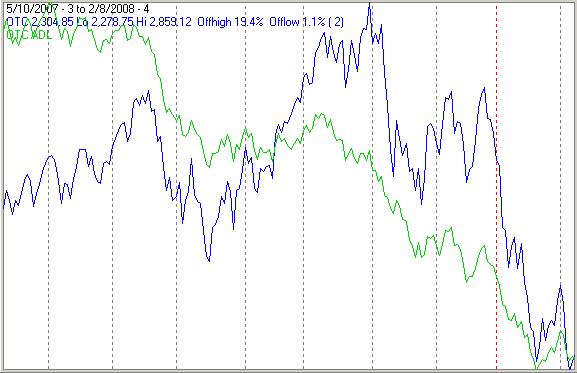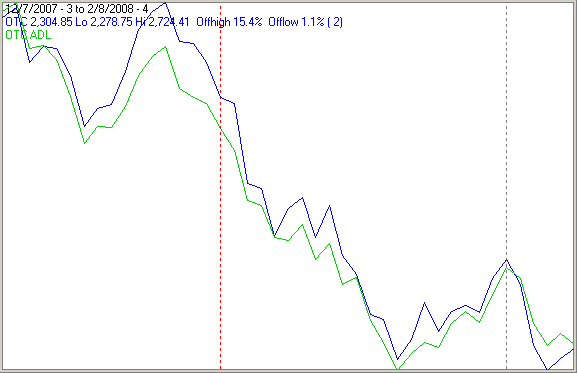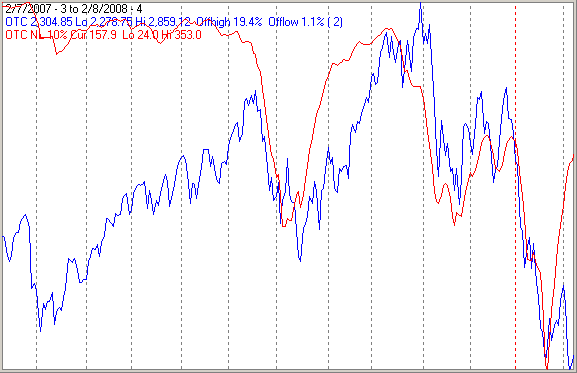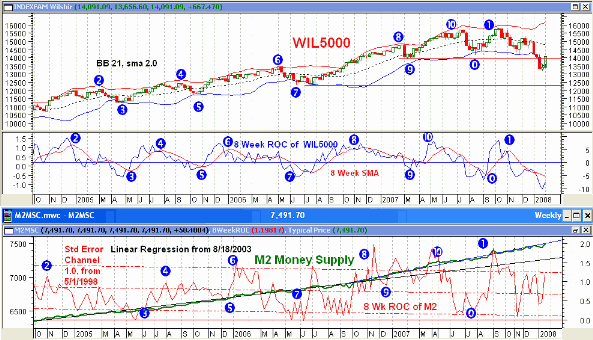Stock Market Intermediate Term Bottom In Place - Expecting Stocks to Rally Next Week
Stock-Markets / US Stock Markets Feb 10, 2008 - 03:47 AM GMTBy: Mike_Burk
The good news is: Although prices fell sharply last week the breadth indicators all held up well.
Short Term - Breadth has been improving.
Market breadth indicators are those derived from advancing issues and declining issues, new highs and new lows and upside and downside volume.
One of the most popular breadth indicators is the advance - decline line (ADL) which is a running total of advancing issues - declining issues. In an ADL all issues get the same representation whereas most indices are capitalization weighted and as such are dominated by the behavior of the large caps. Comparing an ADL to an index reveals what is going on beneath the surface. The tricky part is that most ADL's have a slightly negative bias that must be considered but ADL's constructed from fixed income issues have a wildly positive bias. The expansion of fixed income issues on the NYSE over the past 20 years has made me suspicious of NYSE breadth data. The NASDAQ has relatively few fixed income issues.
The chart below covers the past 9 months showing the NASDAQ composite (OTC) in blue and the NASDAQ ADL in green. Dashed vertical lines have been drawn on the 1st trading day of each month.
You can see how the ADL has been mostly flat while the OTC was rising and fell sharply when the index was weak.

The next chart covers just the last 2 months from the above chart to provide a closer look. Both the ADL and the index hit a low on January 22. The index hit a lower low last Wednesday while the ADL did not, an encouraging sign. However, on Friday the ADL fell while the index rose.

The secondaries lead both up and down and since the middle of January the secondaries have been outperforming the blue chips.
The chart below is from FastTrack (http://fasttrack.net/). It covers the past year showing the S&P 500 (SPX) in green, the Russell 2000 (R2K) in red and a relative strength indicator called Accutrack as a histogram in yellow.
When Accutrack is above the 0 line, as it is now, the R2K is outperforming the SPX.

Intermediate Term
The OTC fell to a new cycle low last week and although there was a slight build up of new lows there was not enough to turn the new low indicators downward.
The chart below covers the past year showing the OTC in blue and a 10% trend (19 day EMA) of NASDAQ new lows (OTC NL) in red. OTC NL has been plotted on an inverted Y axis so decreasing new lows move the indicator upward (up is good).
Last August the OTC went to a new low about a week after the indicator began moving upward. Last week OTC NL continued moving sharply upward while the OTC went to a new low. Until the OTC NL turns downward again there is unlikely to be a significant decline below last week's lows.

The bad news is the extreme number of new lows in mid January implies another retest of the recent lows in the next few months.
Seasonality
Next week is the week prior to the 3rd Friday in February during the 4th year of the Presidential Cycle.
The tables show the daily change of the OTC and S&P 500 (SPX) for the week prior to the 3rd Friday in February during the 4th year of the Presidential Cycle. OTC data covers the period from 1964 - 2004 and SPX data from 1953 - 2004. There are summaries for both the 4th year of the Presidential Cycle and all years combined. Data prior to 1953 has been omitted because the market traded 6 days a week.
Since 1980 returns for the week have been mostly negative.
Report for the week before the 3rd Friday of February.
The number following the year is the position in the presidential cycle.
Daily returns from Monday through 3rd Friday.
| OTC Presidential Year 4 | ||||||
| Year | Mon | Tue | Wed | Thur | Fri | Totals |
| 1964-4 | 0.46% | -0.05% | -0.05% | 0.32% | -0.27% | 0.41% |
| 1968-4 | 0.00% | -1.11% | -0.91% | 0.21% | 0.34% | -1.47% |
| 1972-4 | -0.49% | 0.29% | 0.60% | 0.07% | -0.03% | 0.44% |
| 1976-4 | 0.00% | -0.16% | -1.79% | 3.34% | 0.98% | 2.36% |
| 1980-4 | -0.48% | 0.07% | 0.25% | -0.87% | -0.60% | -1.63% |
| 1984-4 | -1.37% | 0.74% | 0.12% | -0.35% | -0.20% | -1.06% |
| Avg | -0.78% | -0.03% | -0.35% | 0.48% | 0.10% | -0.27% |
| 1988-4 | 0.00% | 0.42% | 0.15% | 0.10% | 0.42% | 1.09% |
| 1992-4 | 0.00% | -1.57% | -0.64% | 1.58% | -0.39% | -1.03% |
| 1996-4 | 0.07% | -0.75% | 0.07% | 0.23% | 0.02% | -0.35% |
| 2000-4 | 0.53% | 0.05% | 0.16% | 2.74% | -3.02% | 0.45% |
| 2004-4 | 0.00% | 1.30% | -0.19% | -1.47% | -0.39% | -0.74% |
| Avg | 0.30% | -0.11% | -0.09% | 0.63% | -0.67% | -0.12% |
| OTC summary for Presidential Year 4 1964 - 2004 | ||||||
| Avg | -0.21% | -0.07% | -0.20% | 0.54% | -0.29% | -0.14% |
| Win% | 50% | 55% | 55% | 73% | 36% | 45% |
| OTC summary for all years 1963 - 2007 | ||||||
| Avg | 0.03% | -0.09% | 0.01% | 0.21% | -0.16% | -0.02% |
| Win% | 55% | 48% | 56% | 62% | 49% | 56% |
| SPX Presidential Year 4 | ||||||
| Year | Mon | Tue | Wed | Thur | Fri | Totals |
| 1956-4 | -0.14% | -0.37% | 1.43% | -0.50% | 1.60% | 2.02% |
| 1960-4 | -0.52% | -0.80% | 0.55% | 1.40% | 0.79% | 1.42% |
| 1964-4 | 0.08% | 0.00% | 0.24% | -0.32% | 0.23% | 0.23% |
| 1968-4 | 0.00% | -0.88% | 1.20% | 0.18% | -0.38% | 0.12% |
| 1972-4 | -0.47% | 0.42% | 0.56% | -0.03% | -0.29% | 0.19% |
| 1976-4 | 0.00% | -0.62% | 0.81% | 1.56% | 0.68% | 2.43% |
| 1980-4 | -0.70% | 0.67% | 0.46% | -1.45% | -1.12% | -2.15% |
| 1984-4 | -0.86% | 1.07% | -0.23% | -0.08% | -0.25% | -0.35% |
| Avg | -0.68% | 0.13% | 0.56% | 0.04% | -0.27% | 0.05% |
| 1988-4 | 0.00% | 0.85% | -0.24% | -0.50% | 1.43% | 1.55% |
| 1992-4 | 0.00% | -1.24% | 0.22% | 1.38% | -0.59% | -0.23% |
| 1996-4 | 0.77% | -0.14% | -0.74% | -0.65% | -0.51% | -1.28% |
| 2000-4 | 0.20% | 0.88% | -1.03% | 0.04% | -3.04% | -2.94% |
| 2004-4 | 0.00% | 0.98% | -0.45% | -0.41% | -0.26% | -0.14% |
| Avg | 0.49% | 0.27% | -0.45% | -0.03% | -0.59% | -0.61% |
| SPX summary for Presidential Year 4 1956 - 2004 | ||||||
| Avg | -0.21% | 0.07% | 0.21% | 0.05% | -0.13% | 0.07% |
| Win% | 38% | 50% | 62% | 38% | 38% | 54% |
| SPX summary for all years 1953 - 2007 | ||||||
| Avg | 0.03% | -0.01% | 0.17% | -0.03% | 0.02% | 0.17% |
| Win% | 44% | 54% | 58% | 47% | 45% | 56% |
Money supply (M2)
This chart has been provided by Gordon Harms.

Conclusion
The sharp decline in prices last week did little damage to the breadth indicators suggesting an intermediate term bottom is in place.
I expect the major indices to be higher on Friday February 15 than they were on Friday February 8.
By Mike Burk
To subscribe to this report : http://alphaim.net/signup.html
Gordon Harms produces a Power Point for our local timing group. You can get a copy of that at: http://www.stockmarket-ta.com/ .
Disclaimer: Mike Burk is an employee and principal of Alpha Investment Management (Alpha) a registered investment advisor. Charts and figures presented herein are believed to be reliable but we cannot attest to their accuracy. Recent (last 10-15 yrs.) data has been supplied by CSI (csidata.com), FastTrack (fasttrack.net), Quotes Plus (qp2.com) and the Wall Street Journal (wsj.com). Historical data is from Barron's and ISI price books. The views expressed are provided for information purposes only and should not be construed in any way as investment advice. Furthermore, the opinions expressed may change without notice.
Mike Burk Archive |
© 2005-2022 http://www.MarketOracle.co.uk - The Market Oracle is a FREE Daily Financial Markets Analysis & Forecasting online publication.



